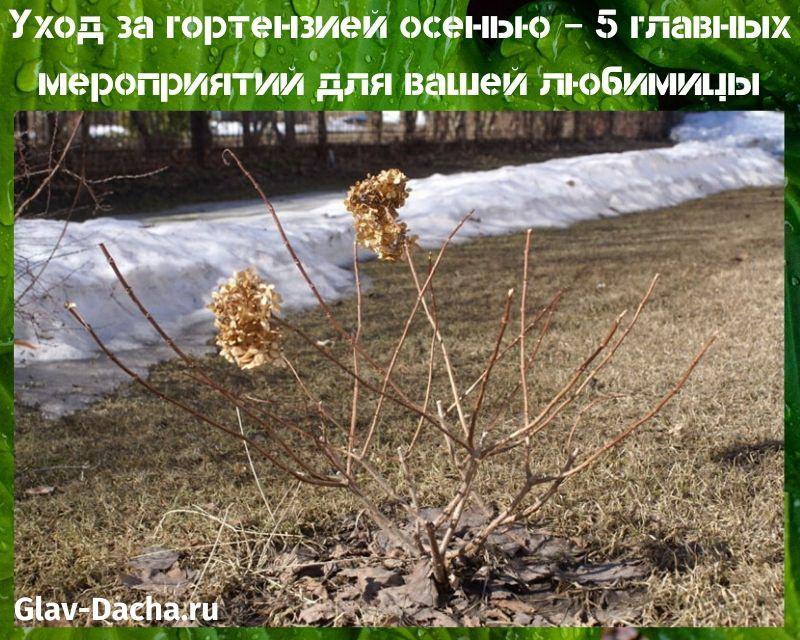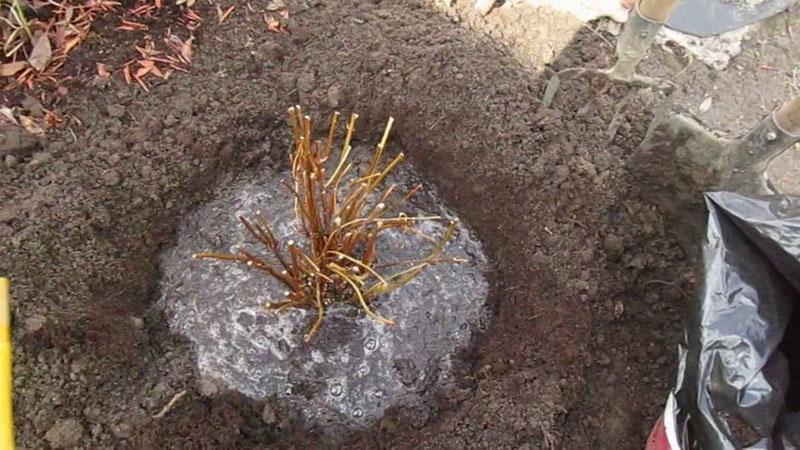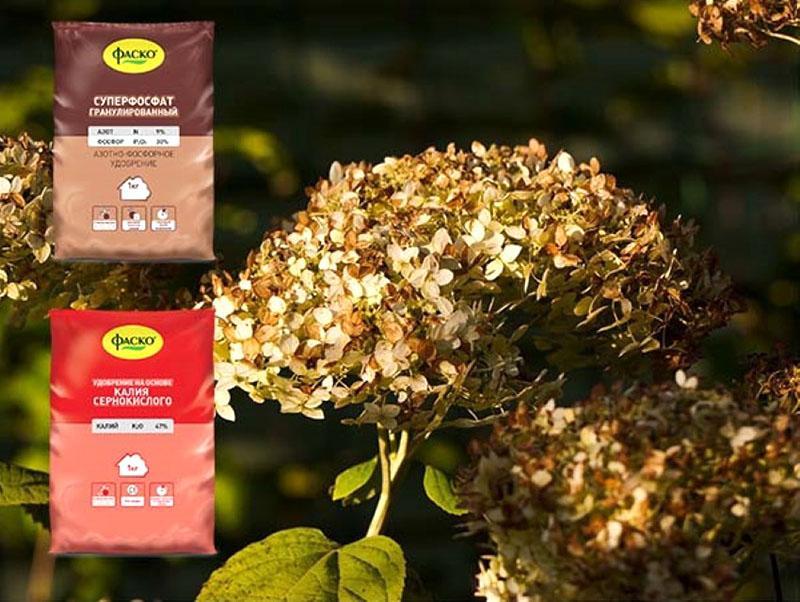Hydrangea care in autumn - 5 top activities for your pet
 Once a curiosity, the beautiful hydrangea is increasingly seen in summer cottages due to its gorgeous bloom. But in order to admire the lush inflorescences every year, it is important to provide proper care for the hydrangea in the fall. Originally from faraway Japan, whose climate is much warmer and milder than ours, in the Russian expanses this perennial becomes finicky. Harsh winters, lack of moisture and poor soil will nullify all efforts. Hydrangea cannot grow by gravity, like a weed, and at the same time bloom. She needs regular care, and the lion's share of the activities falls in time for the fall. It is important to carefully prepare the bush for wintering so that it enters it strong and healthy. And also protect it from frost, because not all types of culture will be able to survive our winters.
Once a curiosity, the beautiful hydrangea is increasingly seen in summer cottages due to its gorgeous bloom. But in order to admire the lush inflorescences every year, it is important to provide proper care for the hydrangea in the fall. Originally from faraway Japan, whose climate is much warmer and milder than ours, in the Russian expanses this perennial becomes finicky. Harsh winters, lack of moisture and poor soil will nullify all efforts. Hydrangea cannot grow by gravity, like a weed, and at the same time bloom. She needs regular care, and the lion's share of the activities falls in time for the fall. It is important to carefully prepare the bush for wintering so that it enters it strong and healthy. And also protect it from frost, because not all types of culture will be able to survive our winters.
So, at the end of the growing season, you should do the following activities:
- water charging irrigation;
- autumn feeding;
- preventive treatment;
- trimming;
- sheltering bushes.
Each procedure has its own characteristics depending on what kind of hydrangea is growing in the garden.
Hydrangea care in autumn - why do you need watering

The exception is wet and rainy autumn, when the earth is already oversaturated with moisture. Here another problem may already arise - waterlogging from natural precipitation.
If there are frequent showers, it is better to cover the soil under the bush with a film. The roots that have absorbed a lot of moisture will freeze, which will lead to the death of the entire bush.
Hydrangea care in autumn - how to feed the plant
 When choosing fertilizers for autumn feeding, you can be guided by the general requirements for garden plants. This means providing the shrubs with potassium and phosphorus. They will help the hydrangea to regain strength after a violent flowering, which means that it will go into the winter healthy and strong. And they will also guarantee the next flowering and the growth of new shoots. A fertilized bush will lay more growth and flower buds.
When choosing fertilizers for autumn feeding, you can be guided by the general requirements for garden plants. This means providing the shrubs with potassium and phosphorus. They will help the hydrangea to regain strength after a violent flowering, which means that it will go into the winter healthy and strong. And they will also guarantee the next flowering and the growth of new shoots. A fertilized bush will lay more growth and flower buds.
At the same time, not only recommendations are preserved, but also prohibitions for autumn feeding. No nitrogen... Preparations with an increased content of it will not benefit a culture preparing for a dormant period. Moreover, at the moment they will only cause harm, giving an impetus to the active growth of young branches. Such shoots will definitely not survive the winter. They will freeze and weaken the plant itself, making it vulnerable to disease and more.
Cannot be used to feed hydrangeas and wood ash.
Yes, it contains a lot of potassium and is a valuable fertilizer. But at the same time, ash alkalizes the soil, reducing its acidity level. And this is unacceptable for hydrangeas, because they love acidic earth, and, conversely, need acidifying drugs.
Potash-phosphorus fertilizers are best applied twice, starting at the end of summer. The second feeding can be done in the second decade of September.It is convenient to use granular preparations. They are simply scattered dry around the bush. Or they water it with a working solution.
For the autumn feeding of hydrangeas, the following fertilizers are suitable:
- kalimag;
- potassium sulfate;
- superphosphate;
- special complexes for hydrangeas of the Fertika, GreenWorld, Bona Forte trademarks.
From organic matter in the fall, under flowering shrubs, you can make:
- humus;
- infusion of bird droppings or mullein;
- biohumus;
- herbal infusion.
Read about:Gaillardia long-term planting and care!
Preventive treatment of hydrangeas in autumn - when and with what
 Spraying of shrubs is carried out after all the leaves have fallen, choosing the appropriate preparation. In the presence of diseases, these will be fungicides. If the plant is attacked by pests - insecticides. For preventive purposes, a solution of Bordeaux liquid (3%) is used.
Spraying of shrubs is carried out after all the leaves have fallen, choosing the appropriate preparation. In the presence of diseases, these will be fungicides. If the plant is attacked by pests - insecticides. For preventive purposes, a solution of Bordeaux liquid (3%) is used.
Not only the entire plant is cultivated, but also the ground under it.
Specific features of pruning hydrangeas
 Many gardeners prefer to prune hydrangeas in the spring and this is generally acceptable. But given the number and size of inflorescences, it is still worth carrying out this procedure in the fall. At least in relation to faded inflorescences - they must be cut off after flowering. If this is not done, in winter the bush will cover with a snow blanket, most of which will settle on dry flowers. Shoots can not withstand such a burden and break. Therefore, it is better to cut the inflorescences in the fall.
Many gardeners prefer to prune hydrangeas in the spring and this is generally acceptable. But given the number and size of inflorescences, it is still worth carrying out this procedure in the fall. At least in relation to faded inflorescences - they must be cut off after flowering. If this is not done, in winter the bush will cover with a snow blanket, most of which will settle on dry flowers. Shoots can not withstand such a burden and break. Therefore, it is better to cut the inflorescences in the fall.
Also, before winter, it is worth carrying out sanitary pruning by removing the following branches:
- dry;
- affected by the fungus;
- growing wrong;
- young shoots thickening the bush.
In the early years, while the seedling is still young and is only in the process of growing the crown, no drastic actions are taken. It will be enough just to remove the broken and dry branches. Pruning an adult hydrangea depends on what species it belongs to.
Pruning and caring for panicle hydrangea in autumn
 A feature of this variety is that flower buds are laid on the current growth. Last year's branches will not bloom, even if they are left and not cut. The plant also differs in appearance. It is taller, the color of the bark and leaves is darker. And instead of almost perfectly round inflorescences, pyramidal buds bloom on the tops of the bush.
A feature of this variety is that flower buds are laid on the current growth. Last year's branches will not bloom, even if they are left and not cut. The plant also differs in appearance. It is taller, the color of the bark and leaves is darker. And instead of almost perfectly round inflorescences, pyramidal buds bloom on the tops of the bush.
It is difficult to harm this hydrangea by untimely pruning. All the same, flower buds will appear only on young branches.
Therefore, pruning panicle hydrangea in the fall can be done in two ways:
- only by removing dry inflorescences, and leaving the rest of the work for the spring;
- immediately cutting the bush completely, shortening the skeletal branches to 3 buds.
With full autumn pruning of shrubs growing in cold regions, it is advisable to leave spare buds. So, shortening is best done not up to 3, but up to 4-5 kidneys, in case they freeze out.
How to prune a tree hydrangea in the fall
 This type of culture also lays flower buds on young growth. In summer, white corymbose clusters bloom on its tops. After some time, small flowers begin to cast a green tint. Tree hydrangea is one of the most unpretentious and frost-resistant, especially the classic old varieties.
This type of culture also lays flower buds on young growth. In summer, white corymbose clusters bloom on its tops. After some time, small flowers begin to cast a green tint. Tree hydrangea is one of the most unpretentious and frost-resistant, especially the classic old varieties.
Like the panicle, the tree-like variety can only be freed from dry inflorescences in the fall. Then the main pruning will be done in the spring. But, since it does not bloom on last year's branches, you can immediately shorten them in the fall. Moreover, such a hydrangea is distinguished by rapid growth and over the summer it grows a lot of young growth that thickens the bush. There is no point in leaving it - there will be no buds, but it will take food from young branches. And this will affect their flowering, which will be poor and weak.
In autumn, branches from 4 years old are completely cut out from old bushes. And also zero shoots that did not bud in the current season.The main branches are cut for flowering, shortening to a couple of buds.
Treelike hydrangea can be shortened the most - to stumps 15 cm high. It grows quickly.
Features of pruning large-leaved hydrangea
 The main difference between this type is the formation of flower buds only on last year's branches. Therefore, the large-leaved hydrangea requires more attention, because it is necessary to preserve these shoots. Otherwise, the bush will not bloom next year. It is better to transfer all pruning procedures to spring time. In autumn, it will be enough just to remove the faded inflorescences to lighten the crown. You can also cut out last year's branches that were taken away in the summer. You don't need to touch anything else. Both anti-aging and sanitary haircuts are carried out in the spring.
The main difference between this type is the formation of flower buds only on last year's branches. Therefore, the large-leaved hydrangea requires more attention, because it is necessary to preserve these shoots. Otherwise, the bush will not bloom next year. It is better to transfer all pruning procedures to spring time. In autumn, it will be enough just to remove the faded inflorescences to lighten the crown. You can also cut out last year's branches that were taken away in the summer. You don't need to touch anything else. Both anti-aging and sanitary haircuts are carried out in the spring.
When pruning inflorescences, it is important not to touch the upper buds on the stems. The cut should not reach them at least 1.5 cm.
Hydrangea care in autumn - is it necessary to cover
 One of the last autumn activities is preparing for winter - shelter. In warm southern regions, it is often overlooked, especially when growing paniculate and tree hydrangea. These species are distinguished by good frost resistance. However, in the event of freezing, this will not affect either the general appearance or the flowering of the plant. Treelike varieties recover quickly, and the panicle hydrangea also grows back. In addition, both varieties bloom on young shoots, which means they will not receive much damage.
One of the last autumn activities is preparing for winter - shelter. In warm southern regions, it is often overlooked, especially when growing paniculate and tree hydrangea. These species are distinguished by good frost resistance. However, in the event of freezing, this will not affect either the general appearance or the flowering of the plant. Treelike varieties recover quickly, and the panicle hydrangea also grows back. In addition, both varieties bloom on young shoots, which means they will not receive much damage.
The named species are simple enough mulch late autumn. The bushes are spud with a mixture of peat, coniferous litter and humus. Such a blanket will serve as both root protection and fertilizer. And it will acidify the soil, which is only "on hand" hydrangea.
A completely different situation with large-flowered (or garden) hydrangea. She is the most capricious and heat-loving. When the branches freeze, the shrub will not bloom, because it lays the buds on the shoots leaving in winter. Therefore, large-flowered varieties must be covered.
 You can begin to shelter garden hydrangeas in the first half of October, as soon as the daytime temperature drops to 8 ° C. They are not afraid of damping, but they already suffer from the first frost.
You can begin to shelter garden hydrangeas in the first half of October, as soon as the daytime temperature drops to 8 ° C. They are not afraid of damping, but they already suffer from the first frost.
In order to create reliable frost protection:
- Cut the leaves at the bottom of the branches.
- Gently pull them together, fixing with twine.
- Wrap it up with two layers of spandbond, securing it with a rope.
- A mesh frame is erected that exceeds the height of the bush by at least 15 cm. It should also be slightly wider so that a void forms.
- Fallen leaves from the garden are poured into the frame.
- Wrap it in foil.
In the same way, oakleaf and serrated hydrangeas are sheltered for the winter.
So, how well a hydrangea will feel and how to bloom depends largely on autumn care. Before wintering, it is important to "water" and "feed" the bush so that it will enter the winter strong. Pruning correctly will help take the strain off and improve flowering quality. And, of course, less resistant species definitely need shelter.